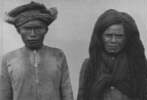| CONTENTS: Traditional dances of Palu
Three types of traditional music
Silk ikat weaving in Donggala
Learn more about the Kaili Culture from someone who
is Kaili |
|
Traditional Kaili Dances
There are several types of traditional dance styles in Palu, but the most important can
be classified into two groups. These are:
A. Authentic Traditional Dances
B. New Traditional Dances
The major styles of authentic traditional dance
still practised in Palu include:
1. Peulucinde Dance : Used in welcoming
ceremonies, Peulucinde dancing is usually performed by three dancers. One dancer carries
yellow rice, while the others carry a cinde (a twisted yellow sarong used for
traditional ceremonies).
2. Pandaleka Dance (Royal Funeral Dance) :
Traditionally performed as a dance of last respects for the deceased king while the body
is carried to the cemetary. Panaleka is usually performed by six fmale dancers. While the
dance is performed there is also singing accompanied by flute music. The flute, made of
wood, is called "lalove" in the local language.
3. Topotaro Dance : The Topotaro dance is
taken from a traditional balia ceremony (a ceremony performed to cure an ill
person, or to communicate with ancestors). It is a form of trance dancing performed by
four females and four male dancers.
New traditional dances are based on old styles by
incorporate modern themes. The most important dances include:
1. Baliore Dance : Used during the harvest
celebration in villages, and performed by a group of six female dancers.
2. Pontanu Dance : Describes the story of
weaving the traditional Donggala silk textile (ikat).
3. Maleo Dance : Tells the story of the
endemic Maleo bird laying its eggs. This dance is usually performed by dancers
representing the female and male Maleo birds.
4. Pajoge Maradika (Royal Pageant) Dance :
This is a fan dance used for marriage ceremonies. (Farida Dewi Astrid Handayani)
(BACK TO TOP)
Traditional
Kaili Music
- Lalove (Flute
Music)
- Rego (Vocal Music)
- Kakula (Gong
Music)
Lalove (Flute
Music) : There are still about 12 known
performers of this traditional flute music around Palu. The music often still heard today
at traditional balia ceremonies, which are performed to summon ancestors to assist in
healing a sick family members (see Balia). The flute measures about 1 metre in length, and
is played in much the same way as in Bali; that is by a special breathing technique which
allows the performer to seemingly play endlessly without coming out for air. This
technique has unfortunately not been passed on successfully to new generations of
performers, and therefore this form of flute music is threatened by extinction. Since the
music played at Balia ceremonies is said to pacify the ancestors who inhabit those in
trances and dukun (shaman), the music can be described as soothing ... the performer
continues until the spirit of the ancestor has left the living.
Rego (Vocal Music)
: A vocal music which can also still be
found in areas such as Pipikoro, Biromaru and ? (you tell me). There is no words, only
chants and sounds. Obviously very ancient in origin, it is easy for listeners to draw
parallels to traditional tribal musics found in North America. It is also performed only
for celebrations.
Kakula (Gong
Music) : Although probably the newest of the three musics described
here (much of the tunes are derived from Arabic rather than Asian sources), it is
distinctly different than most gong music in Indonesia. The players of the traditional
music are old now, and I wish I had a DAT recorder to record this music before it is lost
forever. When I first heard it, it reminded me of industrial groups like Test Dept. or
electronic music a la Bruce Gilbert (Cupol). Three people make up an ensemble. One plays a
set of about 10 brass gongs, one plays a large gong, and the last plays a hand-drum. I've
seen one old woman play the big gong with one hand and the drum with the other. Highly
repetitious and hypnotic. There are supposedly seven different traditional pieces, but one
may hear differences in technique if the players are from different villages.
(BACK TO TOP)
Kain Donggala
Silk weaving is still done by Kaili people in and around Palu, most
notably Buluri on the west side of the bay, Tawaeli on the east side, and in the city
itself. The weaving is still done using manual looms. This is one of the only remaining
places in Asia that still produces double-ikat. The only other place in Indonesia is
Tengganan in Bali.
(BACK TO TOP) |


